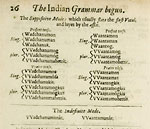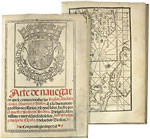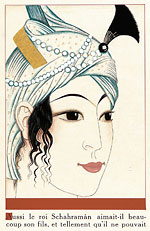All We Are Saying

Algonquin Grammar
$585,650 (£288,500)
Sotheby’s London, March 13
Estimate: $140,000–$200,000 (£40,000–£100,000)
An extremely rare grammar of the Algonquin Indian language, published in Cambridge, Massachusetts in 1666.
 John Eliot was a Cambridge educated, Puritan schoolteacher who left England for Boston in 1631, taking with him 23 barrels of books. For nigh on 60 years he ministered to the educational and spiritual needs of the colonists, but he is best remembered as the “Apostle of the Indians” for the many years he spent working amongst the native inhabitants of eastern Massachusetts.
John Eliot was a Cambridge educated, Puritan schoolteacher who left England for Boston in 1631, taking with him 23 barrels of books. For nigh on 60 years he ministered to the educational and spiritual needs of the colonists, but he is best remembered as the “Apostle of the Indians” for the many years he spent working amongst the native inhabitants of eastern Massachusetts.
Eliot’s magnum opus is the great 1663 Bible in the Natick dialect of the Algonquin Indian tongue, the first Bible of any kind to be printed in North America. But this little grammar, running to just 60 pages and issued in Cambridge, Mass., three years later, is much scarcer than that famous Bible. Described by Eliot in the preface as “some bones and ribs … not worthy of the name of a grammar,” this little book was composed with the help of an Indian who had been a servant in an English house. Eliot includes numerous tables aimed at illuminating the workings of the native tongue—explaining the working of nouns with pronouns, for example, as in muttah (my heart) but kuttah (your heart).
In an 18th-century binding of Dutch floral boards, now cracked at the spine, this copy—the only one seen at auction in a century or more—was secured by London dealers, Maggs Bros. It formed part of the magnificent library of the Earls of Macclesfield at Shirburn Castle, whose dispersal began in 2004 and ended, 12 major sales later, last November. IM

How to Sail
$578,500
Arte de navegar by Pedro de Medina
Christie’s London, June 17
Estimate: $200,000–$300,000
The first practical treatise on navigation, published in 1545.
 First published in Valladolid, Spain, in 1545, this was the first practical treatise on navigation. A seminal text, it was (in a French translation) one of three books on the subject carried by Sir Francis Drake on his 1577-80 voyage around the world. German and Italian translations were also made, but in this original form it is of quite exceptional rarity.
First published in Valladolid, Spain, in 1545, this was the first practical treatise on navigation. A seminal text, it was (in a French translation) one of three books on the subject carried by Sir Francis Drake on his 1577-80 voyage around the world. German and Italian translations were also made, but in this original form it is of quite exceptional rarity.
The author was a cleric and sometime librarian to the Duke of Medina-Sidonia, but also a man who also boasted first hand knowledge of voyaging in the 16th century. He had travelled to the New World with Cortés, and later held debriefing sessions with other returning crews.
The numerous woodcuts in the text include a small, almost notional world map surrounded by headwinds and a much more significant map of the Americas, the Atlantic and parts of Europe and Africa. The map shows trade routes to and from Spain, with the positioning of the little figures of ships indicating an outward south-westerly journey and a return via the Gulf Stream to the northeast. Central America and the Panama Isthmus are accurately delineated and Yucatan is correctly shown as a peninsula.
Offered as part of the Richard Green science library, the treatise was acquired by The 19th Century Shop of Stevenson, Maryland. IM

Livre d’Artiste
$556,000 (€360,000)
Histoire de la princesse Boudour by Joseph-Charles Mardrus
Alde, Paris, June 3
Estimate: $225,000–$300,000 (€150,000–€200,000)
A deluxe illustrated copy of a famous French livre d’artiste.
 There is a long tradition in France of artists hand-decorating books, and whenever these works appear at auction, you can toss out the record books. The Swiss artist Francois-Louis Schmied was perhaps the leading practitioner of the Art Deco woodblock print, and his work was used to illustrate a number of fine press books. Histoire de la princesse Boudour, a tale from the Arabian Nights, found Schmied in peak form, and the limited edition of 20 copies always brings a stunning price when it comes up for auction. In the last ten years, two copies have pushed past $80,000. The copy sold in Paris last year, though, was special. Schmied replaced the woodblock prints with completely new illustrations painted with gouache, or opaque watercolors. It was a one-of-a-kind copy, and completely unknown to Schmied scholars. PSB
There is a long tradition in France of artists hand-decorating books, and whenever these works appear at auction, you can toss out the record books. The Swiss artist Francois-Louis Schmied was perhaps the leading practitioner of the Art Deco woodblock print, and his work was used to illustrate a number of fine press books. Histoire de la princesse Boudour, a tale from the Arabian Nights, found Schmied in peak form, and the limited edition of 20 copies always brings a stunning price when it comes up for auction. In the last ten years, two copies have pushed past $80,000. The copy sold in Paris last year, though, was special. Schmied replaced the woodblock prints with completely new illustrations painted with gouache, or opaque watercolors. It was a one-of-a-kind copy, and completely unknown to Schmied scholars. PSB







